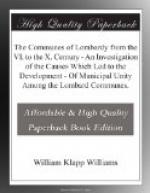commencing with two from the documents which have
already been quoted from Brunetti, relating to the
dispute between the bishops of Siena and Arezzo.
In the first of these[25] we see that in the year
715, the king’s
majordomus Ambrosius
interferes “in Curte a Domini Regis” at
Siena, in opposition to the local bishop and gastald;
and in the second[26] we find the royal notary Gunthram
forbidding a fresh examination of witnesses “in
Curte Regia Senensis.” In a document of
the next year[27]—716—we find
“Ebugansus, Notarius regiae Curtis,” taking
part in the procedure in a case between the bishops
of Pistoia and Lucca; and a little later, in the year
756, is mention of an exchange of property between
“civitis regia lucencis” and the church
situated in that city.[28] In the “Opusculum
de Fundat. Monast. Nonantulae,” published
by Muratori,[29] we find a donation by King Aistulf
to that monastery: “prope castellum Aginulfi,
quod pertinet de curte nostra lucense, et duas casas
masaritias de ipsa curte”; and “granum
ilium, quod annue colligitur de portatico, in Curte
nostra, quae sita est in Civitate Nova."[30] In Carlovingian
times Charles the Bald, in the year 875, in the “Chronica
Farfense,"[31] appears as saying, “in Curte
nostra infra Castrum Viterbense”: elsewhere
“curtis regie Viturbensis” is spoken of[32]:
and later, in 899, Berenger gives to the bishop of
Florence “terram ... pertinentem de curte Regis
istae Florentiae"[33]: and finally, not to multiply
examples, I will mention a privilege of Karloman’s,
published by Ughelli[34], by which he gives to the
bishop of Parma certain regalia: “id est
curtem regiam extructam infra civitatem Parmam cum
omne officio suo,”
etc. From even these
few instances we can see the connection between the
Curtis Regia and the city which gave its name
to the
civitas, a connection the importance
of which we must not fail to appreciate, in consideration
of the great influence which it exercised in the future
development of the municipal unit from a beginning
so insignificant.
Of some importance in connection with the early history
of the cities are the questions which arise in relation
to the fiscal duties and privileges of the curtes
regia and its officers. In it was centered
the fiscal administration of the kingdom; and its officers,
in the various grades from the dux downward,
received and were responsible for the revenues of
the state. So prominent a part belonged to this
form of the functions of the curtes that it
is quite common to hear the revenues themselves, by
a transposition of terms, called by that name, or
by that of palatium, a word sometimes found
even for the curtes regia in their proper general
sense; but this, from what I have been able to gather
concerning its legitimate use, should properly be
applied only to the residence, or by conversion the
revenues of the king himself[35]. What is of interest
to us in this matter is the fact that the curtis
regia fell heir to the publicum or communal
property of the old Roman curia, when these
were overthrown by the Lombard conquest.




